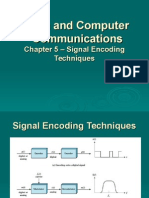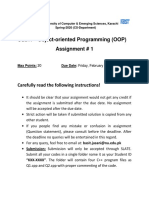0 ratings0% found this document useful (0 votes)
7 viewsEncoding
encoding lecture
Uploaded by
Abdullah AbbasiCopyright
© © All Rights Reserved
Available Formats
Download as PDF, TXT or read online on Scribd
0 ratings0% found this document useful (0 votes)
7 viewsEncoding
encoding lecture
Uploaded by
Abdullah AbbasiCopyright
© © All Rights Reserved
Available Formats
Download as PDF, TXT or read online on Scribd
You are on page 1/ 28
Department of Electrical Engineering.
COMSATS Institute of Information Technology, Islamabad.
PART 2: PHYSICAL LAYER & MEDIA
CHAPTER 4
DIGITAL TRANSMISSION
Conversion Techniques
Data Type Signal Type Approach use
Analog Digital Encoding (Line
coding)
Digital Digital Encoding
(PCM & DM)
Analog Analog Modulation
(AM, FM, PM)
Digital Analog Modulation
(ASK,FSK,PSK)
Line Coding & Decoding
EEE 314: Data Communications 3
& Computer Networks
Data Levels and Signal Levels
Signal Element vs Data Element
EEE 314: Data Communications 5
& Computer Networks
Digital to Digital Conversion
• Technique used for converting digital data
into digital signal is known as Line
Coding.
• It falls into three broad range categories
1.Unipolar
2.Polar
3.Bipolar
EEE 314: Data Communications 6
& Computer Networks
Digital to Digital Conversion
• It falls into three broad range categories
1. Unipolar
2. Polar
3. Bipolar
Unipolar
• Unipolar encoding is the simplest and is
obsolete now.
• It comprises of only one signal level which
mostly is positive. The other usually is zero
voltage.
• Bit rate is same as baud rate i.e one bit per
signal level.
Drawbacks:
• DC component present
• Synchronization which causes loss of data for
long sequence of 0’s and 1’s.
Effect of lack of synchronization
EEE 314: Data Communications 10
& Computer Networks
Polar Encoding
• It uses two voltage levels one is positive
and other is negative
Polar Encoding
NRZ
• Non-Return-to-Zero
• Voltage level is constant during a bit
interval.
• It composes of two schemes.
1. NRZ-L (level)
2. NRZ-I (Inversion)
NRZ
NRZ-L
• 1 = low level
• 0 = high level
NRZ-I
• For each 1 in the bit sequence, the signal
level is inverted.
• Transition from one voltage level to other
represents a 1.
• Drawback:
• No transition for long number of zeros.
Polar NRZ-L and NRZ-I Schemes
EEE 314: Data Communications 17
& Computer Networks
NRZ characteristics
• Two levels
• Bit rate same as baud rate
• Loss of synchronization for long sequence
of 0’s and 1’s.
RZ Encoding
• To overcome the problem of loss of
synchronization RZ is introduced.
• Transition of signal in each bit.
• Three signal levels
• Good synchronization
Drawbacks
• Bit rate is double of baud rate
• Increase in bandwidth
Return to Zero Scheme
EEE 314: Data Communications 20
& Computer Networks
Manchester Biphase Encoding
• The mid-bit transition serves as a clocking
mechanism and also as data.
• Low to high represent a 1 and high to low
represent a 0.
Differential Manchester (biphase)
• Presence of transition in the beginning of a
bit represent a 0.
• Uses inversion in the middle of each bit for
synchronization.
Polar Biphase: Manchester and
Differential Manchester Schemes
EEE 314: Data Communications 23
& Computer Networks
Polar Biphase Encoding
Characteristics
• Two levels
• No DC component
• Good Synchronization
Drawback
• Higher bandwidth due to doubling of baud
rate with respect to data rate.
Bipolar Encoding
• It uses the technique AMI (amplitude
Mark Inversion)
• Uses three voltage levels
• Unlike RZ the zero level is used to
represent a 0.
• Binary 1s are represented by alternating
positive and negative voltages.
Characteristics of Bipolar AMI
• Pseudoternary: same as AMI but
alternating positive and negative pulses
occur for 0 instead of binary 1.
• It has three levels
• No DC components
• Loss of synchronization for long sequence
of 0s
• Lesser bandwidth.
Bipolar Schemes: AMI and Pseudo
ternary
EEE 314: Data Communications 27
& Computer Networks
Relationship between data rate and
baud rate
• D = R/b = R/log2L
Where D is the modulation rate in baud
R is the data rate in bps
L is the number of different signal levels
b is the number of bits per signal element
You might also like
- ECommerce Empire Builders Review Peter Pru Course WorthxmimpNo ratings yetECommerce Empire Builders Review Peter Pru Course Worthxmimp6 pages
- Data Communication Concepts: Dr. Shuchita Upadhyaya Bhasin Professor Department of Computer Science & ApplicationsNo ratings yetData Communication Concepts: Dr. Shuchita Upadhyaya Bhasin Professor Department of Computer Science & Applications14 pages
- Data and Computer Communications: Chapter 5 - Signal Encoding TechniquesNo ratings yetData and Computer Communications: Chapter 5 - Signal Encoding Techniques49 pages
- CSE 315 Lecture-No.5 (Fall 2021) - Line CodingNo ratings yetCSE 315 Lecture-No.5 (Fall 2021) - Line Coding30 pages
- Digital to Digital Conversion in Computer NetworkNo ratings yetDigital to Digital Conversion in Computer Network17 pages
- EEE 367 Telecommunication Engineering: Digital TransmissionNo ratings yetEEE 367 Telecommunication Engineering: Digital Transmission41 pages
- Data Communication CSE 225/233: Week-4, Lesson-1 Digital TransmissionNo ratings yetData Communication CSE 225/233: Week-4, Lesson-1 Digital Transmission23 pages
- Signal Encoding Techniques: Even The Natives Have Difficulty Mastering This Peculiar Vocabulary. - The Golden Bough100% (2)Signal Encoding Techniques: Even The Natives Have Difficulty Mastering This Peculiar Vocabulary. - The Golden Bough56 pages
- Central Women's University: Assignment On TransmissionNo ratings yetCentral Women's University: Assignment On Transmission21 pages
- Radio Engineering - Design Exercise 2016 v1.0No ratings yetRadio Engineering - Design Exercise 2016 v1.022 pages
- CS217 - Object-Oriented Programming (OOP) Assignment # 1: Carefully Read The Following Instructions!No ratings yetCS217 - Object-Oriented Programming (OOP) Assignment # 1: Carefully Read The Following Instructions!2 pages
- Coding and Marking at A Very Low Cost: by MacsaNo ratings yetCoding and Marking at A Very Low Cost: by Macsa8 pages
- Aloha Tableservice Managers Guide Ver 5.3No ratings yetAloha Tableservice Managers Guide Ver 5.3212 pages
- WWW Csselectronics Com Pages Lin Bus Protocol Intro BasicsNo ratings yetWWW Csselectronics Com Pages Lin Bus Protocol Intro Basics18 pages
- Content Writing Master Course: 4 Weeks of Live TrainingNo ratings yetContent Writing Master Course: 4 Weeks of Live Training20 pages
- Oral - Presentation - RT2018 - NCruz - RNC - Software - ArchitectureNo ratings yetOral - Presentation - RT2018 - NCruz - RNC - Software - Architecture14 pages
- Stardom Fcn-Rtu: Low Power Autonomous ControllerNo ratings yetStardom Fcn-Rtu: Low Power Autonomous Controller1 page
- ECommerce Empire Builders Review Peter Pru Course WorthxmimpECommerce Empire Builders Review Peter Pru Course Worthxmimp
- Data Communication Concepts: Dr. Shuchita Upadhyaya Bhasin Professor Department of Computer Science & ApplicationsData Communication Concepts: Dr. Shuchita Upadhyaya Bhasin Professor Department of Computer Science & Applications
- Data and Computer Communications: Chapter 5 - Signal Encoding TechniquesData and Computer Communications: Chapter 5 - Signal Encoding Techniques
- EEE 367 Telecommunication Engineering: Digital TransmissionEEE 367 Telecommunication Engineering: Digital Transmission
- Data Communication CSE 225/233: Week-4, Lesson-1 Digital TransmissionData Communication CSE 225/233: Week-4, Lesson-1 Digital Transmission
- Signal Encoding Techniques: Even The Natives Have Difficulty Mastering This Peculiar Vocabulary. - The Golden BoughSignal Encoding Techniques: Even The Natives Have Difficulty Mastering This Peculiar Vocabulary. - The Golden Bough
- Central Women's University: Assignment On TransmissionCentral Women's University: Assignment On Transmission
- Analog Dialogue, Volume 48, Number 1: Analog Dialogue, #13From EverandAnalog Dialogue, Volume 48, Number 1: Analog Dialogue, #13
- Error-Correction on Non-Standard Communication ChannelsFrom EverandError-Correction on Non-Standard Communication Channels
- CS217 - Object-Oriented Programming (OOP) Assignment # 1: Carefully Read The Following Instructions!CS217 - Object-Oriented Programming (OOP) Assignment # 1: Carefully Read The Following Instructions!
- WWW Csselectronics Com Pages Lin Bus Protocol Intro BasicsWWW Csselectronics Com Pages Lin Bus Protocol Intro Basics
- Content Writing Master Course: 4 Weeks of Live TrainingContent Writing Master Course: 4 Weeks of Live Training
- Oral - Presentation - RT2018 - NCruz - RNC - Software - ArchitectureOral - Presentation - RT2018 - NCruz - RNC - Software - Architecture






























































































